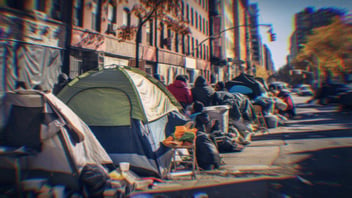Over The Borderline: An Introduction.
 Image Description: The Statue of Liberty from a low vantage point.
Image Description: The Statue of Liberty from a low vantage point.
In March of 2022 we published an episode and essay titled Immigration Nation: A Crisis of our Own Design. It spoke to the complexities of immigration policy in the United States, arguing that our current approaches are inadequate for addressing the challenges posed by mass migration, especially from Central America. The argument being that the only true solution to the backlog of cases, the so-called “Dreamers” in limbo and surge of new entrants across the southern border is a more nuanced and comprehensive strategy; one that considers the root causes of immigration and the broader impacts on society and the economy.
At the heart of the issue is the dichotomy between liberal and conservative approaches to immigration. The politicization of migrants has detached us from rational policy approaches. Liberals like to appear empathetic and advocate for more open borders and compassionate treatment of immigrants, while conservatives demonize and “other” those seeking a new life in the United States and emphasize border security while employing nativist rhetoric.
Miles of border walls, drones and radar technology won’t solve the underlying problems that drive people to migrate in the first place. And, by the way, neither will policy alone. We tend to look at immigration through the America-first lens, no matter whose view we adopt. What’s lost in the debate are the stories of those who seek refuge in the United States.
Many immigrants from Latin America are fleeing poverty, violence, and political instability in their home countries. The same is now true of a surge in refugees from Central Africa. Then there’s the influx of Chinese immigrants who have traveled to South America to traverse the well worn path of the U.S. southern border as well. Suddenly, things aren’t so simple.
It’s folly to think we can solve the world’s problems and abruptly halt the flow of immigration into the U.S. Also, this is just bad for business. Immigration is and has always been a vital part of the American story. Even those sympathetic to the cause of migrants—both those who take a favorable humanistic view and those who take a more cynical exploitative view—understand the benefits of a diverse and expanding population. Corporations want talent. Farms want experienced farmhands. Restaurants need labor. Hopefully we all want to save families who are literally starving or in danger. But there’s a balance.
But now the system is totally clogged. Students, asylum seekers, visa applicants, those going through the naturalization process—everything is delayed or intractably stuck. Any logical policy prescription must consider the root causes of net migration, why people are risking their lives to come here and what, if anything, we had to do with these circumstances.
As it is, the current immigration system is rife with inefficiencies and injustices. The backlog of immigration cases is staggering, with some immigrants waiting years or even decades for their cases to be resolved. According to the Government Accountability Office, there are more than 2 millions cases pending in the woefully understaffed and underfunded immigration courts as of the end of the year. That figure has tripled since 2017 and has only gotten worse since the beginning of 2024.
This backlog not only creates hardship for the individuals involved but also undermines the integrity of the immigration system as a whole. Delays in processing cases can lead to prolonged separation of families and uncertainty for individuals seeking legal status in the United States.
While Republicans ramp up their vicious attacks on immigrants in the runup to the election, exactly as they did in 2016 and 2020, The Biden Administration has sat with a thumb up its ass letting the problem get out of control. As a result, the attacks are striking nerves in more than just border towns.
Trump’s success in 2016 was more due to the antipathy toward Hillary Clinton, the slow and underwhelming recovery under Obama and a little bit of “this outta be interesting.” But the fact that he ran so hard on the border gave life to the idea that nativist campaign messaging might be a winning hand. But that came unraveled in 2020 when the nation threw up its hands in exhaustion and the Trump administration blew everything from the pandemic to promises made to the MAGA base.
But this time is different. We covered the numbers. On balance, there was little historical difference in attempted border crossings over several decades. Only the rhetoric had changed. The crisis that wasn’t in prior election years has actually developed into an authentic crisis that is very much a real thing today. It’s actually staggering how much things have worsened since we wrote that original piece. And it’s not just border states and towns that are waking up to this reality. It’s places like New York City, a sanctuary city with right to shelter laws in place. At this moment, city agencies estimate that more than 67,000 immigrants are still in the care of New York City and State with little federal assistance and little oversight from agencies stretched so thin other services are beginning to fall to pieces. No one is handling this well and it’s tearing us apart.
While some argue that immigrants take jobs away from American citizens and strain public resources, the reality is more nuanced. Immigrants contribute to the economy through their labor, entrepreneurship, and consumption. Studies have shown that immigrants are more likely to start businesses than native-born Americans, creating jobs and stimulating economic growth.
We also demonstrated how even undocumented workers with falsified documents wind up contributing to the Social Security trust even though they’re ineligible for benefits. Basically helping to prop up the system through the underground economy. A dirty secret Washington doesn’t like to talk about.
Furthermore, immigrants often take on jobs that many Americans are unwilling to do, such as agricultural work and low-skilled labor. Without immigrant labor, certain industries would struggle to function, leading to higher prices for consumers and economic instability. We don’t have to like this but it’s true.
Given these complexities, it’s time for a more holistic approach to immigration policy. This includes not only addressing the root causes of migration but also reforming the legal immigration system to make it more efficient and humane. This could involve increasing the number of visas available for both high-skilled and low-skilled workers, as well as providing a pathway to citizenship for undocumented immigrants who are already living and working in the United States. But it also involves a coordinated foreign policy and economic development approach. It’s not enough to focus on the border and processing paperwork. There are fundamental economic and security issues in neighboring nations that must also be addressed as part of a comprehensive strategy.
And, yes, a more compassionate approach to immigration enforcement includes ensuring that immigrants are treated with dignity and respect, regardless of their legal status.
Over the next few episodes, we’re going to dig deeper into the nuances of immigration. The good, the bad, the ugly. The extraordinary and the human side. Personally, I have several burning questions that I can’t wait to answer. And there are perspectives that I’m curious to understand. If we think about the elements at play it’s a rich and troubling narrative. The undercurrent of racism and our nativist tendencies. The impact of climate change on migration patterns. The hangover of neoliberal policies in Latin America and the Caribbean. The housing shortage in the United States. The broken welfare system. The policy of criminalizing immigrants that was institutionalized in the 90s under the Clinton administration. The parallels and extremely poor reactions to the European migrant crisis. The exacerbated homeless crisis as a result of overpopulated shelters.
Then, of course, there’s the question of identity. Who are these people? Who are we? Are we a nation of immigrants on plaques and history books only? Why are we seemingly hardwired to slam the door behind us? To answer all of these questions and address the nuances, we have to look within ourselves and outside of ourselves.
I’ve mentioned recently that I’m fearful of what the next several months holds for us as a nation. The conservative playbook is quite clear and should scare the shit out of anyone with a heart. The liberal playbook is in reality more of the same but written in more flowery verses. But my fear is that the reality of the crisis is showing up in polling data, which means the party in power might overcorrect in a show of strength and hundreds of thousands of innocent people whose only crime is seeking the promise of a new life will be caught tragically in the middle. And, oh by the way, that promise? It’s one we made.
Coming this weekend, our first stop in the series. Spotlight, New York City. See you then, Unf*ckers.
Max is a basic, middle-aged white guy who developed his cultural tastes in the 80s (Miami Vice, NY Mets), became politically aware in the 90s (as a Republican), started actually thinking and writing in the 2000s (shifting left), became completely jaded in the 2010s (moving further left) and eventually decided to launch UNFTR in the 2020s (completely left).


